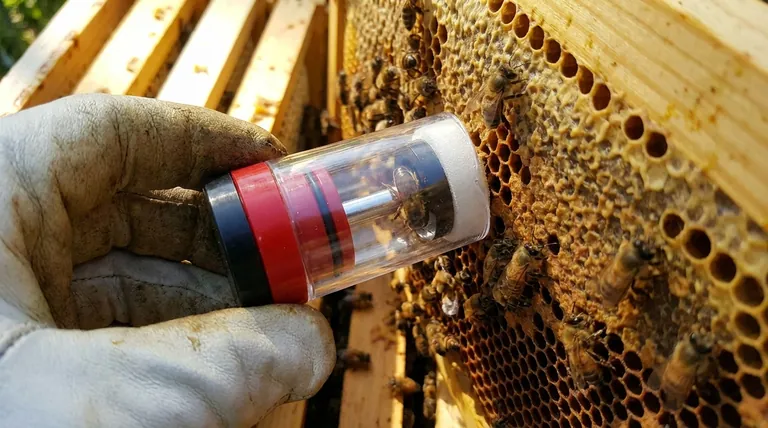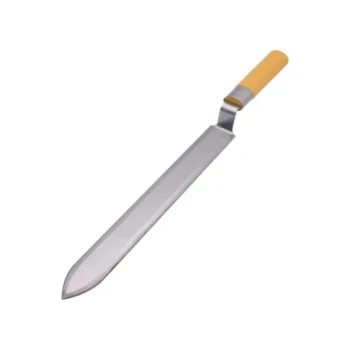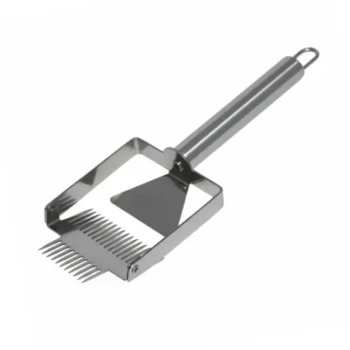The primary advantage of a one-handed queen catcher is its ability to let you safely isolate and immobilize a queen directly on the comb using only one hand. This single-handed operation frees your other hand to hold a marking pen or steady the frame, dramatically simplifying what is otherwise a delicate and high-stakes procedure.
The core value of this tool is not just convenience; it is about transforming a stressful, high-risk task into a controlled, low-stress process for both the beekeeper and the queen.

The Core Challenge: Handling the Queen
Handling a queen bee is one of the most critical tasks in beekeeping. The health and productivity of the entire colony rest on her well-being, making any direct interaction a moment of high tension.
The Risk of Manual Handling
Attempting to pick up a queen by her wings or thorax with your fingers requires significant dexterity and a calm demeanor. A slight mistake can easily injure or kill her, and the fear of this outcome causes hesitation and stress for many beekeepers.
The Problem of Worker Bee Interference
When you locate the queen, she is rarely alone. Her retinue of worker bees surrounds her, often obscuring your view and making it difficult to cleanly mark her without trapping or agitating other bees.
How a One-Handed Catcher Solves the Problem
This tool is specifically designed to overcome the primary obstacles of handling a queen bee safely and efficiently.
True One-Handed Operation
The most significant benefit is ergonomic. You can hold the frame steady with one hand while using your other hand to gently place the catcher over the queen and activate the plunger mechanism. Your dominant hand is now free for the actual task of marking.
Gentle Immobilization
A well-designed catcher does not "clamp" the queen. It uses a soft foam plunger to gently press her against the comb's surface. This holds her still without applying harmful pressure, providing a stable target for the marking pen.
Selective Isolation
The catcher features slots or grates in its design. These openings are large enough for worker bees to exit but too small for the queen to escape. Within seconds, the queen is isolated from her attendants, giving you a clear and unobstructed view.
Understanding the Trade-offs
While highly effective, the tool is not without its considerations. Objectivity requires acknowledging its limitations.
Requires a Gentle Touch
The primary risk comes from user error. Applying too much pressure with the plunger can still injure the queen. The beekeeper must learn to use a light, confident touch to secure her without causing harm.
Not a Transfer Cage
This tool is designed for temporary immobilization on the frame. It is not suitable for transporting a queen to a different hive or for banking queens. For those tasks, a dedicated queen clip or transport cage is the appropriate tool.
A Minor Learning Curve
Like any piece of equipment, it takes a few practice runs to become proficient. You must learn to corner the queen smoothly and apply just the right amount of pressure to the plunger.
Making the Right Choice for Your Goal
To determine if this tool is right for you, consider your primary beekeeping activities.
- If your primary focus is marking queens quickly and safely: This tool is purpose-built for the task, dramatically improving speed and reducing the risk of injury.
- If you are a new beekeeper nervous about handling the queen: A one-handed catcher provides a crucial layer of security, allowing you to confidently manage her without direct finger contact.
- If your goal is simply to find and inspect the queen: The tool is still useful for briefly isolating her so you can get a closer look without losing her in the crowd.
Ultimately, adopting the right tool for the job transforms a difficult procedure into a controlled and confident part of your beekeeping practice.
Summary Table:
| Advantage | Description |
|---|---|
| One-Handed Operation | Frees your other hand to hold a marking pen or steady the frame, making the process much simpler. |
| Gentle Immobilization | Uses a soft foam plunger to hold the queen still on the comb without applying harmful pressure. |
| Selective Isolation | Isolates the queen from her worker bees, providing a clear, unobstructed view for marking. |
| Reduces Stress & Risk | Transforms a high-stakes, delicate task into a controlled and confident procedure for both beekeeper and queen. |
Ready to master queen marking with confidence?
As a trusted supplier for commercial apiaries and beekeeping equipment distributors, HONESTBEE provides the high-quality, durable tools you need for efficient and safe hive management. Our one-handed queen catchers are designed for the demands of professional beekeeping.
Let us equip your operation for success. Contact our wholesale team today to discuss your needs and explore our full range of beekeeping supplies.
Visual Guide

Related Products
- Plastic Queen Bee Catcher Marker Tube Holder for Queen Marking Bottle
- Queen Bee Marking Tube Cage Bottle Catcher Holder with Clear Plastic Plunger Marker
- Double Head Beekeeping Grafting Tools for Beekeepers
- HONESTBEE Professional Multi-Functional Hive Tool with Ergonomic Wood Handle
- Professional Multi-Function Stainless Steel Hive Tool
People Also Ask
- What is a tube queen cage, and how is it used? A Guide to Safe Queen Marking
- What tools and skills are needed to mark a queen bee? Master the Art of Safe & Effective Queen Marking
- What is the purpose of a queen catcher in beekeeping? Safely Handle Your Queen Bee
- When is the best time to mark a queen bee? Ensure Colony Success with Proper Timing
- How can queen marking benefit small-scale beekeepers? Boost Efficiency & Hive Health



















